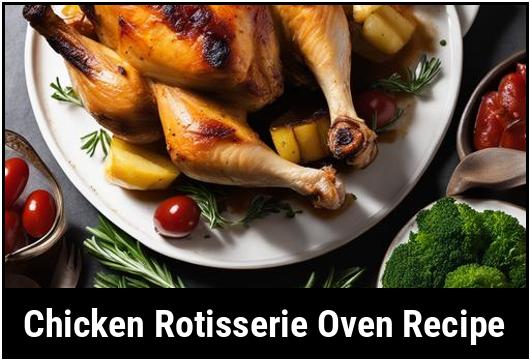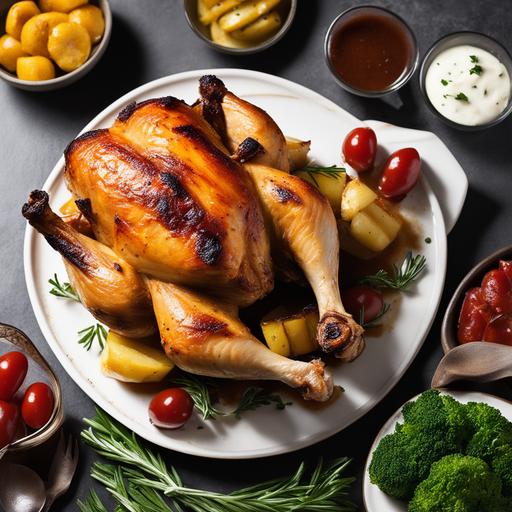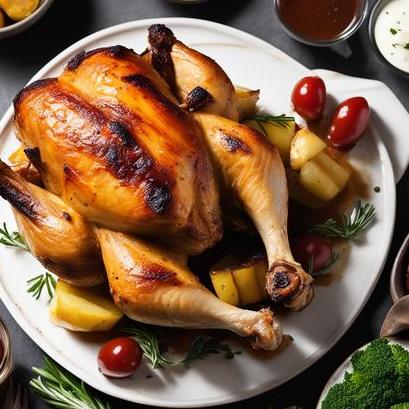
The Ultimate Guide To Cooking Perfect Chicken In A Rotisserie Oven
Are you a chicken lover looking to elevate your culinary skills in the comfort of your own home? Look no further! In this comprehensive guide, we will take you on a journey to master the art of cooking the most succulent and flavorful chicken using a rotisserie oven. Whether you’re a beginner or an experienced chef, this article will equip you with all the knowledge and tips you need to create mouthwatering chicken dishes that will leave your family and friends begging for more.
Understanding the Science Behind Rotisserie Cooking
Before diving into the cooking process, let’s explore the science behind rotisserie cooking and why it yields such incredible results. The concept of rotisserie cooking involves rotating the chicken continuously, resulting in even heat distribution and self-basting. This gentle rotation allows the natural juices within the chicken to circulate, creating a moist and tender texture while enhancing the flavors.
Choosing the Perfect Chicken
Selecting the right chicken is essential to achieve a delectable rotisserie dish. Opt for a fresh, whole chicken rather than frozen or pre-cut pieces. Look for plump, firm breasts, and make sure the skin is smooth and free from blemishes. Organic and free-range options are always excellent choices as they tend to have superior flavor and texture.
Cleaning and Preparing the Chicken

Properly cleaning and preparing your chicken is crucial for both food safety and flavor. Follow these steps to ensure you start with a pristine and delicious bird:
-
Rinse the chicken thoroughly under cold water, inside and out.
-
Pat the chicken dry using paper towels.
-
Gently loosen the skin from the breast and thigh areas. This allows seasonings and flavors to penetrate the meat effectively.
-
Remove excess fat from the cavity and the tail area.
Seasoning and Marinating
One of the most exciting aspects of cooking chicken in a rotisserie oven is the opportunity to infuse the meat with a wide range of flavors. Here are some popular and mouthwatering seasoning and marinade options:
Classic Lemon-Herb Marinade
-
1/4 cup lemon juice
-
2 tablespoons olive oil
-
2 cloves garlic, minced
-
1 tablespoon fresh thyme, chopped
-
1 tablespoon fresh rosemary, chopped
-
Salt and pepper to taste
Combine all ingredients in a bowl, then pour over the chicken. Allow the chicken to marinate for at least 2 hours, or even overnight, to enhance the flavors.
Spicy Barbecue Rub
-
2 tablespoons paprika
-
1 tablespoon brown sugar
-
1 tablespoon chili powder
-
1 teaspoon cayenne pepper (adjust to your preferred level of spiciness)
-
1 teaspoon salt
-
1 teaspoon black pepper
-
1 teaspoon garlic powder
Mix all the spices together until well combined. Rub the mixture all over the chicken, making sure to cover every inch. Let the chicken rest for at least 30 minutes before cooking to allow the flavors to penetrate the meat.
Feel free to experiment and create your unique combinations based on your taste preferences.
Tips for Perfect Rotisserie Chicken
To ensure your chicken turns out tender, juicy, and full of flavor, here are some valuable tips to keep in mind:
Trussing the Chicken
Trussing involves tying the chicken securely with cooking twine. This helps maintain its shape during cooking and ensures even heat distribution. Start by tying the legs together, then bring the wings close to the body and secure them with the twine.
Preheating the Rotisserie Oven
Preheat your rotisserie oven to the recommended temperature before cooking. This allows for consistent heat throughout the cooking process, guaranteeing a perfectly cooked chicken.
Positioning the Chicken
Place the trussed chicken securely onto the rotisserie spikes, making sure it is balanced. This helps the chicken cook evenly and prevents it from touching the sides of the oven, resulting in a crispy skin.
Basting for Extra Moisture
During the cooking process, periodically basting the chicken with its own juices or marinade can add an extra layer of flavor and moisture. Using a basting brush, gently coat the chicken while it rotates, taking care not to interrupt the cooking process.
Monitoring Internal Temperature
To ensure the chicken reaches the desired level of doneness, it’s crucial to use a meat thermometer. Insert the thermometer into the thickest part of the chicken’s thigh, being careful not to touch the bone. The chicken is safe to eat when the internal temperature reaches 165°F (74°C).
Variations and Experimentation

Once you’ve mastered the classic rotisserie chicken recipe, don’t be afraid to explore a variety of flavors and techniques. Here are some ideas to spark your creativity:
Asian-Inspired Glaze
-
1/4 cup soy sauce
-
2 tablespoons honey
-
1 tablespoon sesame oil
-
1 tablespoon rice vinegar
-
2 cloves garlic, minced
-
1 teaspoon grated ginger
Mix all the ingredients in a bowl, then brush the glaze onto the chicken throughout the cooking process. This glaze imparts a delightful umami flavor and creates a beautiful glossy appearance.
Smoky Paprika and Orange Rub
-
2 tablespoons smoked paprika
-
Zest of 1 orange
-
1 tablespoon brown sugar
-
1 tablespoon olive oil
-
Salt and pepper to taste
Combine all the ingredients to form a thick paste. Massage the paste thoroughly into the chicken and allow it to rest for an hour or more before cooking to infuse the flavors.
Overcooking vs. Undercooking
Avoiding overcooked or undercooked chicken is a top priority to ensure a memorable dining experience. Overcooked chicken can become dry and tough, while undercooked chicken poses food safety risks. Here are signs of overcooking and undercooking, along with suggestions for rectifying the situation:
Overcooked Chicken:
-
Dry and stringy texture
-
Loss of natural juices
-
Color turning white throughout
-
Solution: Baste the chicken with a bit of chicken broth or melted butter, cover it with foil, and cook for a few more minutes to add moisture back.
Undercooked Chicken:
-
Pink or reddish appearance
-
Juices appearing slightly bloody
-
Internal temperature below 165°F (74°C)
-
Solution: Continue cooking the chicken until it reaches the safe internal temperature, ensuring it is properly cooked through.
The Perfect Chicken Rotisserie Oven Recipe
Now that you have gained all the essential knowledge, it’s time to put it into practice with this delicious and foolproof chicken recipe.
Ingredients:
-
1 whole chicken (3-4 lbs)
-
2 tablespoons olive oil
-
Seasoning or marinade of your choice
-
Kitchen twine for trussing
Instructions:
-
Preheat your rotisserie oven to 375°F (190°C).
-
Prepare the chicken by cleaning, patting dry, and trussing it.
-
Rub the chicken with olive oil, ensuring it is fully coated.
-
Season the chicken generously with your chosen seasoning or marinade, making sure to cover all areas.
-
Secure the chicken onto the rotisserie spikes, ensuring it is balanced and centered.
-
Place the chicken in the preheated rotisserie oven and start the cooking process.
-
Periodically baste the chicken with its own juices or marinade to add moisture and flavor.
-
Monitor the internal temperature using a meat thermometer in the thickest part of the thigh.
-
Once the chicken reaches a safe internal temperature of 165°F (74°C) and the juices run clear, remove it from the rotisserie oven.
-
Allow the chicken to rest for 10-15 minutes before carving. This allows the juices to redistribute, ensuring optimal flavor and tenderness.
Conclusion
Congratulations! You are now equipped with the knowledge and skills to create perfect rotisserie chicken every time. Remember to choose the freshest chicken, experiment with marinades and rubs, and pay attention to cooking times and temperatures. With practice, you’ll become a master at creating delectable and flavorful chicken dishes that will impress family and friends alike. So fire up your rotisserie oven, and let your culinary journey begin!
Sources
FAQS On Chicken Rotisserie Oven Recipe
What Type Of Chicken Is Best For A Rotisserie Oven Recipe?
Whole chickens with a weight between 3 to 4 pounds work best for rotisserie oven recipes. Make sure the chicken is fresh and not frozen.
What Spices And Herbs Should Be Used To Season The Chicken?
You can use a variety of spices such as garlic powder, onion powder, paprika, cumin, chili powder, black pepper, and salt. You can also add herbs like thyme, rosemary, or oregano for extra flavor.
How Long Should The Chicken Roast In The Rotisserie Oven?
Depending on the size of the chicken, it should take between 1 to 2 hours to cook in a rotisserie oven. The internal temperature of the chicken should reach 165°F for safe consumption.
Can Vegetables Be Roasted With The Chicken?
Yes, you can add vegetables such as potatoes, carrots, and onions to the rotisserie basket to cook with the chicken. Make sure to cut them into uniform sizes for even cooking.
How Do I Ensure The Chicken Stays Juicy During Cooking?
Baste the chicken with melted butter or oil every 20 to 30 minutes while cooking to keep it moist. You can also place a cup of water under the chicken to create a steamy environment. Finally, let the chicken rest for 10 minutes once it’s done cooking to allow the juices to redistribute.



